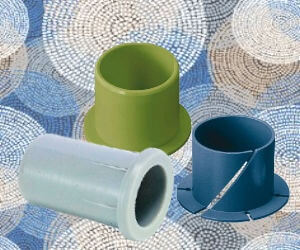There is far more to selecting a polymer bushing than just making sure the PV limit is acceptable and the dimensions are adequate.
In this blog post, we are going to look at five key performance criteria to be considered when looking for the optimal polymer bushing for your application.
Factor 1: PV
While PV isnt the only performance criteria for selecting a bushing, it is still one of the most key criteria. As you probably already know, the P in PV stands for bearing pressure, which is directly related to the distribution of the loading over the bearing and dependent on both the type of bearing and the type of loads it will be expected to carry. The V stands for bearing speed or surface speed, and depends on the bearing dimensions and the type of bearing. The combined PV factor takes into account the effects of both pressure and speed to help you choose a bearing that will provide an acceptable life.
Factor 2: Temperature
It is a known fact that temperature is directly tied to bearing performance. For example, anything that can raise the operating temperature of a bearing, whether its friction, pressure, running speed, or environmental effects, can adversely affect the performance and life of the bearing. In addition, some polymers dont perform well at cryogenic temperatures while others simply cannot survive at extremely high temperatures. When selecting a bearing for an application, it is important to keep in mind the normal operating temperature and well as any expected fluctuations in temperature.
Factor 3: Mating Hardware
You cannot specify an ideal bushing without considering the mating hardware. The surface hardness and surface finish of the shaft will have a tremendous impact on the performance of the bearing. Depending on the polymer used for the bushing material, there are industry standard recommendations for both shaft hardness and surface finish or surface roughness.
Factor 4: Lubrication
There are some applications where lubrication is not recommended, such as cryogenic conditions (where lubrication can freeze) or uses where the lubricant itself would act as a contaminant. Certain polymers, like PTFE and PEEK, are considered dry running polymers that do not require lubrication. There are also self-lubricating polymers that eliminate the need for lubrication either because of their natural behavior (PTFE) or through the addition of additives (such as graphite or molybdenum disulfide). Lubrication constraints should never be an afterthought in bushing design.
Factor 5: Bearing Media
Keep in mind the media that the bearings and bushings will be in contact with, both on a regular basis and on an intermittent basis (e.g., cleaning, sanitation). This includes chemicals as well as the forms that media may take, such as abrasive particles. Always check the potential bushing materials for both chemical compatibility and possible issues with abrasion.
Conclusion
When designing the perfect polymer bushing for an application, there are certain performance criteria that are vital: PV factor, temperature, mating hardware, lubrication, and bearing media. Careful consideration of these criteria during the design phase will help guarantee that your bushing will have a long life with optimum performance.
Interested in reading more about polymer bearing performance? You might enjoy these articles:
- 6 Key Reasons PEEK Works Well for High Performance Bushings
- The Five Most Popular Materials for Polymer Bushings and the Strengths of Each
{{cta(‘1128e85a-f85a-4aaf-978c-19e7174ed752’)}}

